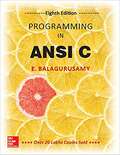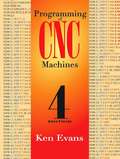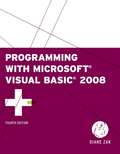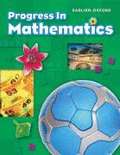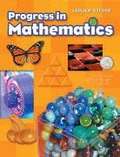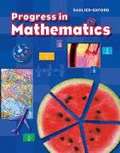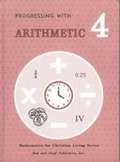- Table View
- List View
Programming for Parks, Recreation, and Leisure Services: A Servant Leadership Approach (3rd Edition)
by Donald G. Degraaf Debra J. Jordan Kathy H. DegraafThis book is about the art and science of the complete programming process. The authors strive to go beyond merely presenting the knowledge and skills needed to provide quality programs; they suggest the integration of values into this process. They do this from a servant leadership perspective.
Programming in ANSI C
by E. BalagurusamyAccessible textbook of Programming in ANSI C, eighth edition by E. Balagurusamy. A text book with theoretical and practical approach to learning ANSI C programming with examples and exercises. It contains concepts from elementary to advanced level programming covering critical concepts, such as Arrays, Strings, Functions, Pointers, Self-referential Structures, Dynamic Memory Allocation, etc. which makes this book a great reference guide for the beginners as well as advanced learners.
Programming in Haskell
by Graham HuttonHaskell is a purely functional language that allows programmers to rapidly develop clear, concise, and correct software. The language has grown in popularity in recent years, both in teaching and in industry. This book is based on the author's experience of teaching Haskell for more than twenty years. All concepts are explained from first principles and no programming experience is required, making this book accessible to a broad spectrum of readers. While Part I focuses on basic concepts, Part II introduces the reader to more advanced topics. This new edition has been extensively updated and expanded to include recent and more advanced features of Haskell, new examples and exercises, selected solutions, and freely downloadable lecture slides and example code. The presentation is clean and simple, while also being fully compliant with the latest version of the language, including recent changes concerning applicative, monadic, foldable, and traversable types. This new edition has been extensively revised and expanded, including four new chapters as well as many new examples and exercises. Fully compliant with the latest version of Haskell, and updated to include more recent features. An accompanying website provides a range of supporting materials, including PowerPoint slides and Haskell code for the extended examples. <P><P><i>Advisory: Bookshare has learned that this book offers only partial accessibility. We have kept it in the collection because it is useful for some of our members. To explore further access options with us, please contact us through the Book Quality link on the right sidebar. Benetech is actively working on projects to improve accessibility issues such as these.</i>
Programming of CNC Machines
by Ken EvansWritten in a simple, easy-to-understand language by a skilled programmer with many years of experience teaching CNC machining to industry and in the classroom, this new edition offers a new chapter on feature-based Machining using Siemens, plus a new chapter featuring Fanuc NC guide I programming. It provides full descriptions of many operation and programming functions and illustrates their practical applications through examples. It provides in-depth information on how to program turning and milling machines, which is applicable to almost all control systems. It keeps all theoretical explanations to a minimum throughout so that they do not distort an understanding of the programming. And because of the wide range of information available about the selection of tools, cutting speeds, and the technology of machining, it is sure to benefit engineers, programmers, supervisors, and machine operators who need ready access to information that will solve CNC operation and programming problems.
Programming with Microsoft® Visual Basic® 2008
by Diane ZakProgramming with Microsoft Visual Basic 2008, Fourth Edition by the best-selling author, Diane Zak, is designed for a first course in programming. Using the most recent version of the software, Visual Basic 2008, this book teaches individuals how to use Visual Basic applications as they would in a real world setting. Students with no previous programming experience learn how to plan and create their own interactive windows applications. GUI design skills and Object-Oriented Programming concepts are emphasized throughout the book.
Progress In Mathematics: Grade 3
by Catherine D. Le Tourneau Rose A. McDonnell Anne V. Burrows*This textbook has been transcribed in UEB, formatted according to Braille textbook formats, proofread and corrected. <P><P>SADLIER-OXFORD Progress In Mathematics grade 3 student textbook.
Progress Monitor, English Language Arts, [Grade] 5, Student Benchmark Assessments
by William H. SadlierProgress Monitor, English Language Arts, [Grade] 5, Student Benchmark Assessments
Progress in Mathematics (Grade #5)
by Elinor R. Ford Alfred S. Posamentier Catherine D. LetourneauProgress in Mathematics includes a "handbook" of essential skills, Skills Update, at the beginning of the text. These one-page lessons review skills you learned in previous years.
Progress in Mathematics [Grade 1]
by Alfred Posamentier Catherine Letourneau Elinor FordA publisher-supplied textbook
Progress in Mathematics [Grade 1]
by Elinor R. Ford Alfred S. Posamentier Catherine D. LetourneauA publisher-supplied textbook
Progress in Mathematics [Grade 2]
by Alfred Posamentier Catherine Letourneau Elinor FordA publisher-supplied textbook
Progress in Mathematics [Grade 2]
by Elinor R. Ford Alfred S. Posamentier Catherine D. LetourneauA publisher-supplied textbook
Progress in Mathematics [Grade 3]
by Alfred Posamentier Catherine Letourneau Elinor FordA publisher-supplied textbook
Progress in Mathematics [Grade 3]
by Elinor R. Ford Alfred S. Posamentier Catherine D. LetourneauA publisher-supplied textbook
Progress in Mathematics [Grade 4]
by Alfred Posamentier Catherine Letourneau Elinor FordA publisher-supplied textbook
Progress in Mathematics [Grade 4]
by Elinor R. Ford Alfred S. Posamentier Catherine D. LetourneauA publisher-supplied textbook
Progress in Mathematics [Grade 5]
by Alfred Posamentier Catherine Letourneau Elinor FordA publisher-supplied textbook
Progress in Mathematics [Grade 5]
by Elinor R. Ford Alfred S. Posamentier Catherine D. LetourneauA publisher-supplied textbook
Progress in Mathematics [Grade 6]
by Elinor R. Ford Alfred S. Posamentier Catherine D. LetourneauA publisher-supplied textbook
Progress in Mathematics [Grade K]
by Elinor R. Ford Alfred S. Posamentier Catherine D. LetourneauA publisher-supplied textbook
Progress, English Language Arts, Level E
by Robert M. Johnson Kathy W. Dames Lillie LewisNIMAC-sourced textbook
Progress, English Language Arts, Level H
by Robert M. Johnson Kathy W. Dames Lillie LewisNIMAC-sourced textbook
Progressing With Arithmetic Grade 4
by Lester Miller Timothy Conley Sandra BaumanThis hardcover textbook has 170 lessons, counting tests. Teaches the multiplication and division facts 10's-12's, long division, multiplying by 2-digit numbers, and checking. Reading problem skills include distance-rate-time, 2-step problems, using sketches, and identifying missing information. Also covers place value, decimals, Roman numerals, scale drawings, metric units of length, fractions, geometry, and graphs.

